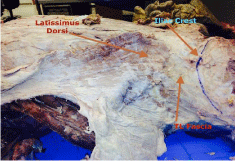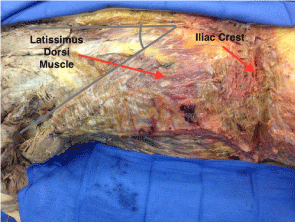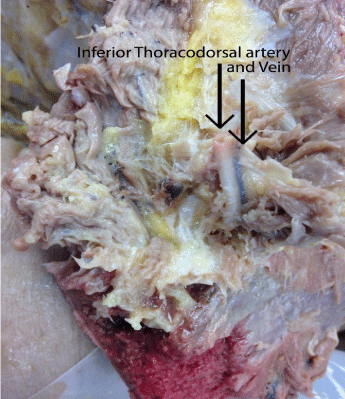Research Article
Exploring the Extended Latissimus Dorsi Myocutaneous Flap: A 55 Cadaver Study
Ali Roham*, Aamir Siddiqui, Thaddeus Boucree, Vigen Darian and Doreen Ganos
Department of Plastic and Reconstructive Surgery, Henry Ford Macomb Hospital, USA
*Corresponding author: Ali Roham, Department of Plastic and Reconstructive Surgery, Henry Ford Macomb Hospital, 1016 Greenleaf Dr Royal Oak, MI 48067, USA
Published: 02 Nov, 2016
Cite this article as: Roham A, Siddiqui A, Boucree T, Darian
V, Ganos D. Exploring the Extended
Latissimus Dorsi Myocutaneous Flap:
A 55 Cadaver Study. Clin Surg. 2016;
1: 1173.
Abstract
Background: The latissimus dorsi muscle has long been a valuable muscle for reconstruction. Our study aims to determine the true anatomic origin of the latissimus dorsi muscle and identify the
possibility of performing an extended musculocutaneous flap for better aesthetic outcome and
avoiding the need of implant based reconstruction to add volume.
Methods: 55 human cadaver bodies were dissected to evaluate the origin attachment point. Our
aims were to determine how frequently the latissimus dorsi flap can be extended distally and
determine its origin of attachment as the thoracolumbar fascia alone or in combination with the
posterior iliac crest.
Results: The latissimus dorsi muscle had a 62% rate of muscular origin attachment being the
thoracolumbar fascia alone, and a 38% rate of muscular origin of attachment being the thoracolumbar
fascia in combination with the posterior iliac crest. The muscle was found to be shorter when the
origin was the thoracolumbar fascia as opposed to when the origin was the thoracolumbar in
combination with the posterior iliac crest. When the LD muscles origin was the thoracolumbar
fascia alone the quadratus lumborum attached to the PSIS.
Conclusion: As such a valuable reconstructive tool, we have underutilized and failed to harvest the
full extent of the latissimus dorsi muscle. The lack of mobilization lies in the failure to understand
the origin, the posterior iliac crest, in minority of patients. When the latissimus dorsi muscular
origin of attachment is both the thoracolumbar fascia and posterior iliac crest, a distally extended
flap can be designed, which will result in better aesthetic outcome for breast surgery.
Keywords: Latissimus Dorsi; Myocutaneous flap; Quadratus lumborum
Introduction
The latissimus dorsi muscle has long been a valuable muscle for reconstructive surgeons. Muscle and musculocutaneous flaps have been a workhorse for many different deformities and deficiencies. The latissimus dorsi musculocutaneous flap breast reconstruction with implant based products can sometimes fail to provide the size, shape and volume necessary to be aesthetically pleasing, as they “fail to provide soft, natural contours resulting in breast mounds with stark contours, minimal ptosis and poor nipple areola complex reconstructions [1].” The purpose of our study is to determine the true anatomic origin of the latissimus dorsi muscle and identify the possibility of performing an extended myocutaneous flap dissection for better aesthetic outcome and avoiding the need of implant based reconstruction to add volume.
Background
Iginio Tansini, an Italian surgeon, first described the mastectomy as the treatment for breast cancer in 1896 while working at the Greater Hospital of Lodi [2]. That paper described the need to remove all of the mammary gland, the muscles, lymphatics and the mammary skin to reduce cutaneous recurrences [2-4]. With this new technique, the large skin defect that remained was covered by the Tansini flap, as this tissue was an ‘autoplastic flap’ with the pedicle based toward the axillary incision and would not contain any cancer remnants. The distal one-third of this ‘autoplastic flap’ would usually necrose. It was not until 1906, while working at the University of Pavia, that Tansini [4] found the latissimus dorsi musculocutaneous flap for the coverage of the defect created by the mastectomy. The latissimus dorsi musculocutaneous flap fell out of favor in part due to inefficiency of medical information transfer at that time and also due to concerns of concealing cancer recurrence. It was not until 1976 that Nevin Olivari [5] was credited with rediscovering the latissimus dorsi musculocutaneous flap for breast reconstruction after mastectomy, and its use in patients with skin and chest wall irradiation. The latissimus dorsi musculocutaneous flap has incorporated a wide range of applications over time, particularly for breast reconstruction. In present day practice, the flap is a good option for breast reconstruction, with or without an implant. Some clinical indications for the use of latissimus dorsi musculocutaneous flap over other reconstruction modalities include women who are not candidates for abdominally based autologous tissue reconstructions. Contraindications to traditional reconstruction may include those with a history of abdominal operations, limited infraumbilical fat, a history of chest wall irradiation who may not tolerate implant based reconstruction, or those whom wound healing is of concern (advanced age, tobacco use, and morbidly obese) [6]. Due to the robust blood supply of the latissimus dorsi muscle and an almost equivalent blood supply to the overlying skin, it is generally accepted that this type of flap is an excellent option for breast reconstruction. Until the 1980s, the latissimus dorsi flap only provided limited soft tissue for reconstruction and was best suited for patients who had small to moderate size breast or those who would undergo contralateral reduction procedure for symmetry.
Anatomy
Between the fourth and eighth week of fetal development, the dorsolateral subpopulation of somatic cells, known as dermomyotome, give rise to myotomes. The cells of the myotomes subdivide into epimeres and hypomeres. The latissimus dorsi muscle is derived from hypomeres, which migrate secondarily into the back in an anterior and lateral direction. The syndetome, which contains the progenitor of the tendons, develops between the myotome and the sclerotome, which gives rise to the bones of the axial skeleton [7]. In an article by Yahia et al. [8], fetal cadaver dissections showed that before 30 weeks of development the most distal fibers of the latissimus dorsi directly inserted on the posterior iliac crest. In that same study, researchers found that after 30 weeks, the thoracolumbar fascia separated the latissimus dorsi from the posterior iliac crest. To our knowledge, this is the only article that describes the variation in the relationship of the latissimus dorsi to the iliac crest. In fact, Gray’s Anatomy describes the latissimus dorsi as having “muscular fibers that spring from the posterior lip of the iliac crest [9].” These various attachments then allow the muscle fibers to adapt 3 patterns, oblique, vertical, and horizontal, as it rises to attach to the intertuburcular sulcus of the humerus. The latissimus dorsi muscle is described as a Type V muscle flap according to the Mathes and Nahai classification due to its dominant vascular pedicle, the thoracodorsal artery, multiple secondary segmental pedicles, and the thoracolumbar perforators from the lower 6 intercostal and lumbar arteries [10]. The segmental branches and thoracodorsal branches have extensive collateralization, which attributes to the success of the latissimus dorsi musculocutaneous flap and skin island. A specific blood supply has not been clearly identified for the distally based latissimus dorsi muscle, thoracolumbar fascia, overlying subcutaneous tissue, and skin paddle.
Figure 1
Figure 1
Cadaver image which shows attachment of the latissimus dorsi muscle to thoracolumbar fascia alone. Note the oblique oriented fibers and the distance from most distal fibers to iliac crest (blue line).
Methods
We included 55 cadaveric models, 110 latissimus dorsi muscles, which were extensively dissected and studied. The study did not require institutional review board approval. The average age, height, weight and race of the cadavers were obtained. The length of the muscle was measured in all cadavers, and the distance between periosteum and muscle fibers measured. The inferior thoracodorsal artery was measured from the lateral side of the posterior superior iliac spine.
Results
The average age of our population was 75.3 years (45-95 years),
with 72% being female. Average height of the cadavers was 171.5 cm
(147-200 cm) with an average weight of 63 kg. The point of origin of
the latissimus dorsi muscle was examined in all models, 110 in total.
The latissimus dorsi muscle was found to have 2 main anatomical
variants, associated with 2 muscle patterns, oblique and vertical. The
latissimus dorsi muscle originated from the thoracolumbar fascia
alone and had no bony attachment into the posterior iliac crest 62%
of the time. When this occurred, the muscle had an oblique pattern
(Figure 1). The latissimus dorsi muscle was found to originate from
both the thoracolumbar fascia and the posterior iliac crest in 38% of
the models. When this occurred, the muscle had a vertical pattern
(Figure 2). In our study, we saw 2 of the 3 muscle patterns, oblique
and vertical which are described in the literature. Variations to
the points of origin correlated specifically to muscle patterns. The
oblique patterns attached to the thoracolumbar fascia alone, while
the vertical had both attachments to the thoracolumbar fascia and the
posterior iliac crest. All of the cadavers exhibited symmetrical points
of attachments between the right and left muscle groups. When the
latissimus dorsi muscle originated from the thoracolumbar fascia
alone, the average length of the muscle was 35.6 cm, and the muscle
fibers extended to within 7.5 cm of the posterior iliac crest periosteum.
When the muscle attached to the thoracolumbar fascia in combination
with the iliac crest, the average length of the muscle was 39.4 cm. In
our study, we have found a consistent arterial blood supply to the
latissimus dorsi musculocutaneous flap, when the latissimus dorsi
muscle and thoracolumbar fascia are found attached to the posterior
iliac crest (Figure 3). This artery arises from the posterior superior
iliac spine, passes superiorly through thoracolumbar and latissimus
dorsi muscle fibers to form a network of multiple angiosomes, and
then reconstitutes with the thoracodorsal artery. This artery has a
network of choke vessels as it matures into the thoracodorsal artery.
It is these similarities that remind us of the relationship between the
inferior and superior epigastric arteries. The inferior thoracodorsal
artery was only present in the vertical pattern when the thoracolumbar
fascia and latissimus dorsi muscle attached to the posterior iliac crest.
The inferior thoracodorsal artery was located 2.4 cm lateral to the
posterior superior iliac spine prominence.
In addition, during our dissection, we found the quadratus
lumborum site of attachment to the posterior iliac crest was absent
if the muscle fibers of the latissimus dorsi and thoracolumbar fascia
had direct attachment to the periosteum. It is interesting that both
the latissimus dorsi muscle and the quadratus lumborum muscle are
derived from the same embryological hypomeres, yet the muscles
had a mutual origin in only a single cadaver model. In this model
both latissimus dorsi and quadratus lumborum attachments to the
posterior iliac crest. This single variation was found on a 75-yearold
man, who was 183 cm tall and weighed 82 kg. Not only was
the periosteum thicker, but also the posterior iliac crest bone was
50% wider in diameter. In this specific specimen, both an inferior
thoracodorsal artery and a perforator to the quadratus lumborum
muscle were found to attach into the periosteum of the posterior
superior iliac crest. Having both latissimus dorsi and quadratus
lumborum attachment to the posterior iliac crest may have increased
the blood flow, and thus, the size of the bone.
Figure 2
Figure 2
The latissimus dorsi muscle (LD) originates from both the iliac crest and thoracolumbar fascia. Note the more vertically oriented muscle fibers.
Figure 3
Figure 3
Inferior thoracodorsal vascular bundle arising from posterior iliac crest, only identified when latissimus dorsi muscle attached to both thoracolumbar fascia and iliac crest.
Discussion
The latissimus dorsi muscle is a large flat triangular muscle that
covers the lower thorax and back. Many anatomists and surgeons
describe the latissimus dorsi as having multiple points of origin,
including the posterior lip of the iliac crest. Our study agrees that the
latissimus dorsi has prominent points of origin: thoracic vertebrae,
lumbar and sacral vertebrae. However, attachment to both the
posterior iliac crest and the thoracolumbar fascia was present in less
than 40% of the population. In 68% of cases, both the latissimus dorsi
attached to the thoracolumbar fascia and failed to have attachments to
the iliac crest. The latissimus dorsi musculocutaneous flap is currently
considered one of the most versatile and reliable musculocutaneous
flaps available for reconstruction of head and neck, chest wall or free
flap reconstructions. The latissimus dorsi musculocutaneous flap has
been used for over a century for reconstruction of skin and soft tissue
defects. During our review of the literature, we identified only 1 article
that provided any insight on the anatomical variation of the latissimus
dorsi muscle. 9 Various muscle fibers patterns have been previously
described as horizontal, oblique, or nearly vertical. We were able to
identify the oblique and vertical pattern as it relates to the origin.
Our research also identified and named the inferior thoracodorsal
artery, because of the similar characteristics it shared with the inferior
and superior epigastric artery. In 1983, Hokin et al. [11] described
the use of the entire latissimus dorsi muscle in combination with
the thoracolumbar fascia, overlying subcutaneous tissue, and a skin
island as this would provide additional volume while preserving the
blood supply beyond the muscle fibers.
The same operative strategy is used in present day procedures,
a distally extended latissimus dorsi musculocutaneous flap that
maximizes the soft tissue provided and minimizes the donor site
defect [1]. Hokin et al. [11] described this distally latissimus dorsi
musculocutaneous flap as a dissection of muscle and overlying
subcutaneous tissue that ended at the posterior iliac crest in an attempt
to add volume and avoid the use of an implant. In our current study,
we found that in 62% of the cadavers, the latissimus dorsi originated
from the thoracolumbar fascia alone and had no attachment to bone.
These muscle fibers were nearly vertical in orientation and stopped
within 7.5 cm of the posterior iliac crest. Therefore, in the majority of
these models, the latissimus dorsi originated from the thoracolumbar
fascia alone, with no bony attachments, and the average muscle length
was significantly shorter at 35.6 cm. There was no blood supply to
support a latissimus dorsi musculocutaneous extended flap in these
specimens. Having such a short muscle would increase the likelihood
of needing an implant for added volume since attempting to dissect
to the bone would not add viable length to the flap.
Hokin’s [11] latissimus dorsi musculocutaneous flap could only
be applied to 38% of our models. In these specimens, the average
length of the muscle was 39.4 cm and could be dissected right off
the posterior iliac crest. The inferior thoracodorsal artery was the
blood supply to the distal portion of the latissimus dorsi muscle,
thoracolumbar fascia, overlying subcutaneous tissue, and skin. This
vessel passed through these tissues as a network of choke vessels and
then attached just lateral to the periostium on the posterior superior
iliac spine in 38% of our dissections. In these cases, an aesthetic breast
could more likely be achieved without the need for an implant or
enhanced with the use of fat grafting.
To apply our anatomic findings to the clinic scenario, it would
be helpful to identify the point of origin prior to surgery or complete
harvesting of the muscle. A study that identifies the point of origin
would allow the surgeon to properly develop a plan individualized
for patients that are candidates for an extended latissimus dorsi
musculocutaneous flap. Another option would be to determine the
pattern of muscle fibers during surgery and determine if the extended
dissection would be a viable option. Otherwise a poor surgical
outcome could be directly correlated to the failure to understand that
less than half of all patients will have an attachment to the posterior
iliac crest.
Acknowledgment
We would like to thank the Wayne State University Department of Anatomy for providing us with the cadavers for our study.
References
- Hammond DC. Latissimus dorsi flap breast reconstruction. Clin Plast Surg. 2007; 34: 75-82.
- Maxwell GP. Iginio Tansini and the origin of the latissimus dorsi musculocutaneous flap. Plast Reconstr Surg. 1980; 65: 686-692.
- Tansini I. Nuovo processo per l’amputazione della mammaella per cancre. Reforma Medica. 1896; 12: 3.
- Tansini I. Sopra il mio nuovo processo di amputazione della mamella. Riforma Med. 1906; 12: 757.
- Olivari N. The latissimus flap. Br J Plast Surg. 1976; 29: 126-128.
- McCarthy CM, Mehrara BJ, Riedel E, Davidge K, Hinson A, Disa JJ, et al. Predicting complications following expander/implant breast reconstruction: An outcome analysis based on preoperative clinical risk. Plast Reconstr Surg. 2008; 121: 1886-1892.
- Schoenwolf GC, Bleyl SB, Brauer PR, Francis-West PH, editors. Larsen’s Human Embryology. 5th edn. Philadelphia, PA: Churchill Livingstone. 2015.
- Ben Hadj Yahia S, Vacher C. Does the latissimus dorsi insert on the iliac crest in man? Anatomic and ontogenic study. Surg Radiol Anat. 2011; 33: 751-754.
- Standring S, editor. Gray's anatomy: The Anatomical Basis of Clinical Practice. Edinburgh, Scotland: Churchill Livingstone. 2008.
- Mathes SJ, Nahai F. Classification of the vascular anatomy of muscles: eperimental and clinical correlation. Plast Reconstr Surg. 1981; 67: 177- 187.
- Hokin JA. Mastectomy reconstruction without a prostethic implant. Plast Reconstr Surg. 1983; 72: 810-818.



